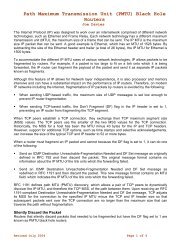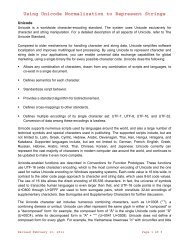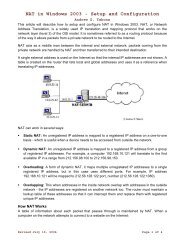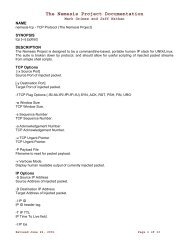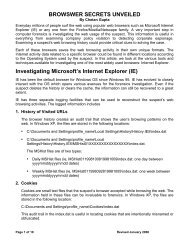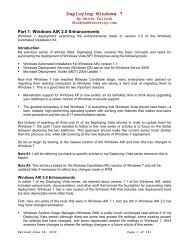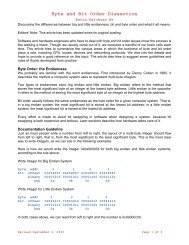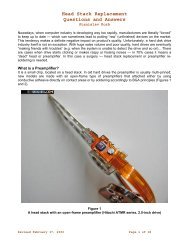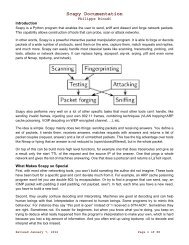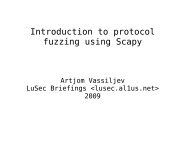Packet Crafting via Hping - Bandwidthco Computer Security
Packet Crafting via Hping - Bandwidthco Computer Security
Packet Crafting via Hping - Bandwidthco Computer Security
You also want an ePaper? Increase the reach of your titles
YUMPU automatically turns print PDFs into web optimized ePapers that Google loves.
<strong>Packet</strong> <strong>Crafting</strong> <strong>via</strong> <strong>Hping</strong><br />
alt_don<br />
The author of this program is Salvatore Sanfilippo. He is a hacker from Agrigento, Italy. So all kudos go<br />
to him for crafting such an excellent tool. He is presently working on v3, and hopefully will be releasing it<br />
soon. There are several tutorials on the web regarding this tool. A couple are by the author himself.<br />
However I found them to be confusing, and often difficult to follow. This is no fault of the author as his<br />
mother tongue is not English.<br />
The reason I chose to learn this tool is very simple. I was curious as to how the people who were<br />
attempting to gain access to our networks were going about it. One of the ways is packet crafting.<br />
<strong>Crafting</strong> packets will allow you to probe firewall rule-sets and find entry points into the targeted system or<br />
network.<br />
The sheer versatility of this tool though is what makes it stand out from the crowd. It is not only the king<br />
of the hill when it comes to crafting packets. This will also show you how to interpret the various<br />
conventions of TCP/IP. You will learn how the guts of the stack works by crafting packets. As mentioned<br />
below you will need to run a packet sniffer to see your output. This will show you exactly what it is that<br />
you are sending out. More importantly though it will show you how various firewalls, open services, and<br />
closed ports react to certain stimulus. This side benefit of HPing and packet crafting in general is highly<br />
underrated. To understand how the web lives and breathes is integral to your computer studies. It stand<br />
to reason that you would want to understand its basic form of communication ie: the packet. The packet<br />
is the foundation upon which C2C (computer to computer) communications are built upon.<br />
The following paper will show you how to use this tool. It will not however teach you how to hack or to<br />
help secure your network. You can do both with HPing. To do both successfully you will need a lot more<br />
knowledge in regards toTCP/IP, routers, access control lists, OSI chart, andother areas.<br />
What I hope to accomplish by this brief is to show you just how easy it is to craft packets, and perhaps<br />
give you a glimpse into the world of the black-hat hacker. Not to mention hopefully stimulate your<br />
curiousity, and encourage you to further explore the murky world of the hacker. The one constant with<br />
hackers of all stripes, whether they be black/white/grey hat is that they have a burning curiosity about<br />
computers.<br />
One last note on HPing before we start to look at it. HPing will run on any Linux distro, as well as<br />
Net/Free/OpenBSD systems, and lastly it will run on Solaris as well. I highly advise you to run tcpdump at<br />
the same time. This will allow you to monitor your crafted packets as well as look at your return packets.<br />
I have included tcpdump snippets to highlight what the outgoing and incoming packets look like on the<br />
wire. I believe this to be important as it allows you to visualize the packets. Be aware that HPing "does<br />
not" run under Windows. You can however still have tcpdump for Windows. It is called windump and can<br />
be found here.<br />
The two packets you see below are just one ip addy sending a Syn packet to another ip addy. To do this<br />
using <strong>Hping</strong> is a very simple task. Just type in "exactly" the below noted command syntax, and voila a<br />
syn packet is sent!<br />
hping -S 10.1.1.1<br />
19:54:34.236334 10.1.1.1.1321 > 10.1.1.1.0: S 897957123:897957123(0) win 512<br />
0x0000 4500 0028 6510 0000 4006 24bd xxxx xxxx E..(e...@.$..r.|<br />
0x0010 xxxx xxxx 0529 0000 3585 bd03 67f0 e290 .r...)..5...g...<br />
0x0020 5002 0200 7aac 0000 <br />
P...z...<br />
19:54:36.227147 10.1.1.1.1323 > 10.1.1.1.0: S 576193543:576193543(0) win 512<br />
Revised January 8, 2012 Page 1 of 8
<strong>Packet</strong> <strong>Crafting</strong> <strong>via</strong> <strong>Hping</strong><br />
alt_don<br />
0x0000 4500 0028 8711 0000 4006 02bc xxxx xxxx E..(....@....r.|<br />
0x0010 xxxx xxxx 052b 0000 2258 0407 0738 40dd .r...+.."X...8@.<br />
0x0020 5002 0200 4940 0000 <br />
P...I@..<br />
The syn packet is the first step in the TCP/IP hand shake. To open communications between two<br />
computers the very first step is to send a syn packet to the computer you wish to communicate with. This<br />
would be followed by the syn/ack, in turn followed by the ack. At this point you are ready for the setup of<br />
communications, and then the exchange of data.<br />
This is one of the most common scans out there today. The Syn scan is also noisy and easily detectable<br />
by properly configured Intrusion Detection Systems such as Snort, Netranger, amongst many others. It is<br />
a good scan to run however due to the conventions of TCP/IP. As mentioned above when an open port<br />
with a service running upon it receives a syn packet it will respond with a syn/ack confirming it is open<br />
and ready for business. Think ofport 25 SMTP, port 110 POP3 amongst others that would respond to this<br />
type of scan. Assuming that they are not hidden behind firewalls that is. Even if they are though the lack<br />
of a response is invaluable information in and of itself. More on that when we look at the rst packet.<br />
Be aware that when you do not specify a destination port on the targeted computer it will default to 0.<br />
Also if you do not specify a source port it will use a random ephemeral port and go up numerically from<br />
there. More on how to specify both src/dst ports later. On with the basics for now.<br />
The below noted packet is a reset packet. The reset packet is used to reset a connection. As you can<br />
see the command syntax is very similar. The only change is in the actual switch itself. Instead of -S it is -<br />
R.<br />
The rst packet is often used to perform what is known as inverse mapping. What this means is that rst<br />
packets are sent out and the response received is what will tell you if the host exists or not. If you send<br />
out a rst scan you would get one of two things. You will either get no response which will indicate to you<br />
that the host is probably alive or an ICMP host unreachable msg. This would indicate that the host does<br />
not exist. This is what is known as inverse mapping. Some IDS systems will not log rst packets/scans<br />
due to the sheer multitude of them. This is why the inverse scan is popular.<br />
hping -R 10.1.1.1<br />
19:54:57.669980 10.1.1.1.1239 > 10.1.1.2.0: R 1975237774:1975237774(0) win 512<br />
0x0000 4500 0028 890e 0000 4006 00bf xxxx xxxx E..(....@....r.|<br />
0x0010 xxxx xxxx 04d7 0000 75bb bc8e 631c a4e4 .r......u...c...<br />
0x0020 5004 0200 7dbb 0000 <br />
P...}..<br />
19:54:58.666747 10.1.1.1.1240 > 10.1.1.2.0: R 225427189:225427189(0) win 512<br />
0x0000 4500 0028 1b76 0000 4006 6e57 xxxx xxxx E..(.v..@.nW.r.|<br />
0x0010 xxxx xxxx 04d8 0000 0d6f bef5 458a 2a1c .r.......o..E.*.<br />
0x0020 5004 0200 7bfa 0000 <br />
P...{...<br />
This packet is a fin packet ie: to close a conx already established. Once again the command syntax is<br />
very similar to the above two examples. The fin packet is also used to perform the fin scan. When a<br />
closed port receives a fin packet it should respond with a rst packet. This will tell you that there are<br />
services on the machine, however they are behind a f/w.<br />
hping -F 10.1.1.1<br />
Revised January 8, 2012 Page 2 of 8
<strong>Packet</strong> <strong>Crafting</strong> <strong>via</strong> <strong>Hping</strong><br />
alt_don<br />
19:55:24.992034 10.1.1.1.1502 > 10.1.1.2.0: F 1235235694:1235235694(0) win 512<br />
0x0000 4500 0028 991c 0000 4006 f0b0 xxxx xxxx E..(....@....r.|<br />
0x0010 xxxx xxxx 05de 0000 49a0 336e 3917 cbd5 .r......I.3n9...<br />
0x0020 5001 0200 3507 0000 <br />
P...5...<br />
19:55:25.986754 10.1.1.1.1503 > 10.1.1.2.0: F 1775365876:1775365876(0) win 512<br />
0x0000 4500 0028 ccb0 0000 4006 bd1c xxxx xxxx E..(....@....r.|<br />
0x0010 xxxx xxxx 05df 0000 69d1 eef4 00c1 98f3 .r......i.......<br />
0x0020 5001 0200 c486 0000 <br />
P.......<br />
The below noted packet is an icmp echo request ie: ping. This packet is useful to determine whether or<br />
not a specific host is up or not. The command syntax is a little different for this packet. We will specify<br />
after hping that we want a icmp packet by putting in the numerical value 1 followed by the ip addy of the<br />
host we are pinging. There are a great many uses for icmp as well as various types of icmp. This<br />
protocol is often used for the ubiquitous ping scan as mentioned above. The obvious reason for this is to<br />
see if specific hosts are alive.<br />
hping -1 10.1.1.1<br />
19:55:46.914365 10.1.1.2 > 10.1.1.1: icmp: echo request<br />
0x0000 4500 001c 20cf 0000 4001 690f xxxx xxxx E.......@.i..r.|<br />
0x0010 xxxx xxxx 0800 13e6 e419 0000 .r..........<br />
19:55:47.906748 10.1.1.2 > 10.1.1.1: icmp: echo request<br />
0x0000 4500 001c ee83 0000 4001 9b5a xxxx xxxx E.......@..Z.r.|<br />
0x0010 xxxx xxxx 0800 12e6 e419 0100 .r..........<br />
The packet below is simply a udp packet. To send one is rather easy as well. We will have to tell hping<br />
that we want a udp packet by putting in the numerical value 2. The default protocol for hping is tcp. This<br />
is why of course we need to tell hping what protocol we wish to send by changing the value.This is of use<br />
when probing services which are udp based vice tcp. Such as netbios, nfs, dns, nis amongst others.<br />
hping -2 10.1.1.1<br />
19:56:39.753975 10.1.1.1.2462 > 10.1.1.2.0: udp 0<br />
0x0000 4500 001c c394 0000 4011 c639 xxxx xxxx E.......@..9.r.|<br />
0x0010 xxxx xxxx 099e 0000 0008 053d .r.........=<br />
19:56:40.746747 10.1.1.1.2463 > 10.1.1.2.0: udp 0<br />
0x0000 4500 001c bdc2 0000 4011 cc0b xxxx xxxx E.......@....r.|<br />
0x0010 xxxx xxxx 099f 0000 0008 053c .r.........<<br />
The below noted packet is a syn packet directed at port 21 aka ftp. To send a syn packet at a specific<br />
port requires a few more switches. This is where the usage of hping begins to shine. As noted below we<br />
are sending a syn (-S) packet to 10.1.1.1 specifically on their ftp port by putting in the (-p) switch. To<br />
specify the destination port you put in the -p. To specify the source port on your machine you want the<br />
packet to go out on you would use the -s switch followed by a port number just as the destination port<br />
example below.<br />
hping -S 10.1.1.1 -p 21<br />
Revised January 8, 2012 Page 3 of 8
<strong>Packet</strong> <strong>Crafting</strong> <strong>via</strong> <strong>Hping</strong><br />
alt_don<br />
19:57:01.789384 10.1.1.1.1548 > 10.1.1.2.21: S 1371884204:1371884204(0) win 512<br />
0x0000 4500 0028 0661 0000 4006 836c xxxx xxxx E..(.a..@..l.r.|<br />
0x0010 xxxx xxxx 060c 0015 51c5 4aac 669b 5b07 .r......Q.J.f.[.<br />
0x0020 5002 0200 58aa 0000 <br />
P...X...<br />
19:57:02.786747 10.1.1.1.1549 > 10.1.1.2.21: S 1979208427:1979208427(0) win 512<br />
0x0000 4500 0028 d63a 0000 4006 b392 xxxx xxxx E..(.:..@....r.|<br />
0x0010 xxxx xxxx 060d 0015 75f8 52eb 364e 01c6 .r......u.R.6N..<br />
0x0020 5002 0200 b5c5 0000 <br />
P.......<br />
The below noted is a push packet directed at a specific port. In this case http port 80. The "payload" in<br />
the push packet should be done up ahead of time in a file that you will specify in the command string.<br />
You will as well have to make sure that the packet length is long enough to handle your payload. Hence<br />
another switch. I will go over and explain each switch one by one for this type of packet.<br />
-P Tells hping to send a push packet<br />
10.1.1.1 This is the destination ip<br />
-d Allows you +/- the size of the packet itself in this case we have set it to 80 bytes<br />
-p Specifies the destination port in this case port 80<br />
-E Tells hping where to look for a file which it is to insert as a payload ie: /home/don/test.sig Quite usefull<br />
obviously for pre-compiled exploits ie: buffer overuns<br />
hping -P 10.1.1.1 -d 80 -p 80 -E /home/don/test.sig<br />
19:58:25.721579 10.1.1.1.2426 > 10.1.1.2.80: P 729845249:729845329(80) win 512<br />
0x0000 4500 0078 4a7b 0000 4006 3f02 xxxx xxxx E..xJ{..@.?..r.|<br />
0x0010 xxxx xxxx 097a 0050 2b80 8e01 5ce6 ac80 .r...z.P+...\...<br />
0x0020 5008 0200 4178 0000 4745 5420 632b 6469 P...Ax..GET.c+di<br />
0x0030 720a 4745 5420 432b 4449 520a 2f2f 6874 r.GET.C+DIR.//ht<br />
0x0040 7470 2031 2e30 0a00 0000 0000 0000 0000 tp.1.0..........<br />
0x0050 0000 0000 0000 0000 0000 0000 0000 0000 ................<br />
0x0060 0000 0000 0000 0000 0000 0000 0000 0000 ................<br />
0x0070 0000 0000 0000 0000 ........<br />
19:58:26.716801 10.1.1.1.2427 > 10.1.1.2.80: P 823113587:823113667(80) win 512<br />
0x0000 4500 0078 732c 0000 4006 1651 xxxx xxxx E..xs,..@..Q.r.|<br />
0x0010 xxxx xxxx 097b 0050 310f b773 7ce2 c9a0 .r...{.P1..s|...<br />
0x0020 5008 0200 d559 0000 4745 5420 632b 6469 P....Y..GET.c+di<br />
0x0030 720a 4745 5420 432b 4449 520a 2f2f 6874 r.GET.C+DIR.//ht<br />
0x0040 7470 2031 2e30 0a00 0000 0000 0000 0000 tp.1.0..........<br />
0x0050 0000 0000 0000 0000 0000 0000 0000 0000 ................<br />
0x0060 0000 0000 0000 0000 0000 0000 0000 0000 ................<br />
0x0070 0000 0000 0000 0000 ........<br />
I will now show you how to do what is called Idle Host Scanning. What this means exactly is that we are<br />
using one machines ip addy to scan the target computer for open services. To simplify I will use a<br />
random ip addy to scan another addy. This I will do by HPing of course. The one other caveat is that<br />
Revised January 8, 2012 Page 4 of 8
<strong>Packet</strong> <strong>Crafting</strong> <strong>via</strong> <strong>Hping</strong><br />
alt_don<br />
someone's machine needs to be idle. Bythat I mean not being used by him. This is needed because<br />
while I am spoofing his address and sending syn packets to my target I will be sending syn packets as<br />
well to his machine to monitor his IP Id numbers. It is through the monitoring of said numbers that we will<br />
know if the target machine has open services or not.<br />
When a machine is idle and you send syn packets to it the IP Id numbers will normally go up in a<br />
predictable sequence. If the sequence varies it is because the host is now active. By this I mean that the<br />
target machine will send to his computer a syn/ack. His machine will respond with an ack packet. This<br />
communication between the two will cause the IP Id numbers to change from it's predictable sequence.<br />
Thus indicating to us that our spoofed machine has found an open port. All this is done without exposing<br />
ourselves to the target machine.<br />
The stacks that are generating predictable IP ID numbers are Win boxes, and older distros of linux.To<br />
accomplish said attack we will need to have two sessions of <strong>Hping</strong> going as well as tcpdump running.<br />
1st session of HPing will contain the below command syntax<br />
hping -S 10.1.1.2 -a 10.1.1.1 -p ++21<br />
-S This again is a syn packet<br />
10.1.1.2 is our target machine<br />
-a The switch used to spoof an ip addy<br />
10.1.1.1 Is the spoofed addy ie: his computer<br />
-p The switch used to specify destination port<br />
++21 Tells hping to syn packet port 21 on up sequentially<br />
The 2nd session of HPing will contain the below noted command syntax:<br />
hping -1 10.1.1.1<br />
By sending icmp packets to his machine I will get back the info I need to execute this. I will get back ttl's<br />
and more importantly of course the IP Id numbers. I will keep pinging his box all the while I am sending<br />
spoofed syn packets to the target machine in the hope they respond. This will result in his machine<br />
changing it's IP Id numbers from it predictable sequence. Thus indicating thatit has found an open port.<br />
Be aware though that this will only work with a middle man with whom you can monitor it's IP Id numbers.<br />
If you have a machine which is running no services, and is firewalled this will not work.<br />
Seen as any packets icmp/syn or otherwise will simply be dropped. Your best bet would be to ask<br />
someone you know who has a broadband account if they would be willing to let you experiment with their<br />
machine. Either way here is a url that does an excellent job of explaining the IP ID attack. There are<br />
many more out there just google for them.<br />
I have included on the next page some examples of HPing strings and the feedback as well as the<br />
tcpdump logs. Feel free to experiment with the below noted. Not just that mess around with fragmented<br />
packets, setting your X and Y flags and the like. You will only learn by playing around. Ideally get a friend<br />
that you can bounce this stuff to, and later go over you results with him/her. That is it for now folks. I<br />
hope I was able to edumacate ya some!<br />
Revised January 8, 2012 Page 5 of 8
<strong>Packet</strong> <strong>Crafting</strong> <strong>via</strong> <strong>Hping</strong><br />
alt_don<br />
These examples are of IP addy's that were bouncing off of my f/w. So I decided to return the favour and<br />
take a looksie for fun. As you can see port 25 SMTP ack'ed back. In case your wondering what all that<br />
gobbledeegook is at the end of the syn/ack packet let me explain.<br />
S denotes a syn packet<br />
973256460:973256460 is the sequence number of the packet<br />
ack 1440279771 is the ack sequence number<br />
win 16616 is the amount of buffered space the machine has to receive info<br />
means the maximum segment size is 1460 this relates to the mtu<br />
mtu means the maximum transmission unit <br />
HPING 24.114.15.186 (eth0 24.114.15.186): S set, 40 headers + 0 data bytes<br />
len=46 ip=24.114.15.186 sport=21 flags=RA seq=0 ttl=122 id=20284 win=0<br />
rtt=48.8 ms<br />
len=46 ip=24.114.15.186 sport=22 flags=RA seq=1 ttl=122 id=20367 win=0<br />
rtt=34.3 ms<br />
len=46 ip=24.114.15.186 sport=23 flags=RA seq=2 ttl=122 id=20505 win=0<br />
rtt=24.9 ms<br />
len=46 ip=24.114.15.186 sport=24 flags=RA seq=3 ttl=122 id=20672 win=0<br />
rtt=25.8 ms<br />
len=46 ip=24.114.15.186 sport=25 flags=SA DF seq=4 ttl=122 id=20767<br />
win=16616 rtt=45.8 ms<br />
len=46 ip=24.114.15.186 sport=26 flags=RA seq=5 ttl=122 id=20879 win=0<br />
rtt=35.8 ms<br />
len=46 ip=24.114.15.186 sport=27 flags=RA seq=6 ttl=122 id=20937 win=0<br />
20:37:18.131546 10.1.1.1.1238 > 24.114.15.186.25: S 1440279770:1440279770(0) win 512<br />
0x0000 4500 0028 1061 0000 4006 7755 xxxx xxxx E..(.a..@.wU.r.|<br />
0x0010 1872 0fba 04d6 0019 55d8 ecda 748e 5412 .r......U...t.T.<br />
0x0020 5002 0200 aa85 0000 P.......<br />
20:37:18.177151 24.114.15.186.25 > 10.1.1.1.1238: S 973256460:973256460(0) ack<br />
1440279771<br />
win 16616 (DF)<br />
0x0000 4500 002c 511f 4000 7a06 bc92 1872 0fba E..,Q.@.z....r..<br />
0x0010 xxxx xxxx 0019 04d6 3a02 b70c 55d8 ecdb .r.|....:...U...<br />
0x0020 6012 40e8 2b62 0000 0204 05b4 0000 `.@.+b........<br />
The same person bouncing off of my f/w. Port 25 SMTP still acking<br />
monkey:/home/don # hping -S 24.114.15.186 -s 1234 -p ++21 -f<br />
HPING 24.114.15.186 (eth0 24.114.15.186): S set, 40 headers + 0 data bytes<br />
len=46 ip=24.114.15.186 sport=21 flags=RA seq=0 ttl=122 id=100 win=0<br />
rtt=52.9 ms<br />
len=46 ip=24.114.15.186 sport=22 flags=RA seq=1 ttl=122 id=101 win=0<br />
rtt=27.0 ms<br />
len=46 ip=24.114.15.186 sport=23 flags=RA seq=2 ttl=122 id=102 win=0<br />
rtt=31.4 ms<br />
Revised January 8, 2012 Page 6 of 8
<strong>Packet</strong> <strong>Crafting</strong> <strong>via</strong> <strong>Hping</strong><br />
alt_don<br />
len=46 ip=24.114.15.186 sport=24 flags=RA seq=3 ttl=122 id=103 win=0<br />
rtt=47.4 ms<br />
len=46 ip=24.114.15.186 sport=25 flags=SA DF seq=4 ttl=122 id=104<br />
win=16616 rtt=28.1 ms<br />
len=46 ip=24.114.15.186 sport=26 flags=RA seq=5 ttl=122 id=105 win=0<br />
rtt=41.1 ms<br />
len=46 ip=24.114.15.186 sport=27 flags=RA seq=6 ttl=122 id=106 win=0<br />
rtt=48.8 ms<br />
Another person this time with port 53 DNS and HTTP port 80 acking back to me<br />
monkey:/home/don # hping -S 24.114.9.226 -s 1234 -p ++21<br />
HPING 24.114.9.226 (eth0 24.114.9.226): S set, 40 headers + 0 data bytes<br />
len=46 ip=24.114.9.226 sport=21 flags=RA seq=0 ttl=118 id=19063 win=0<br />
rtt=227.5 ms<br />
len=46 ip=24.114.9.226 sport=22 flags=RA seq=1 ttl=118 id=19092 win=0<br />
rtt=211.6 ms<br />
len=46 ip=24.114.9.226 sport=23 flags=RA seq=2 ttl=118 id=19132 win=0<br />
rtt=264.6 ms<br />
len=46 ip=24.114.9.226 sport=24 flags=RA seq=3 ttl=118 id=19180 win=0<br />
rtt=419.1 ms<br />
len=46 ip=24.114.9.226 sport=25 flags=RA seq=4 ttl=118 id=19202 win=0<br />
rtt=925.0 ms<br />
len=46 ip=24.114.9.226 sport=53 flags=SA DF seq=32 ttl=118 id=20344<br />
win=16616 rtt=158.2 ms<br />
len=46 ip=24.114.9.226 sport=80 flags=SA DF seq=59 ttl=118 id=21413<br />
win=16616 rtt=151.7 ms<br />
Another person this time with more services open as you can see.<br />
monkey:/home/don # hping -S 164.77.216.98 -s 3133 -p ++21<br />
HPING 164.77.216.98 (eth0 164.77.216.98): S set, 40 headers + 0 data bytes<br />
len=46 ip=164.77.216.98 sport=21 flags=SA DF seq=0 ttl=49 id=0 win=5840<br />
rtt=339.7 ms<br />
len=46 ip=164.77.216.98 sport=22 flags=SA DF seq=1 ttl=49 id=0 win=5840<br />
rtt=2319.8 ms<br />
len=46 ip=164.77.216.98 sport=25 flags=SA DF seq=4 ttl=49 id=0 win=5840<br />
rtt=516.0 ms<br />
len=46 ip=164.77.216.98 sport=53 flags=SA DF seq=32 ttl=49 id=0 win=5840<br />
len=46 ip=164.77.216.98 sport=80 flags=SA DF seq=59 ttl=49 id=0 win=5840<br />
11:18:34.312598 164.77.216.98.21 > 10.1.1.1.3133: S [tcp sum ok]<br />
3829392622:3829392622(0)<br />
ack 1327465401 win 5840 (DF) (ttl 4<br />
9, id 0, len 44)<br />
0x0000 4500 002c 0000 4000 3106 022e a44d d862 E..,..@.1....M.b<br />
0x0010 xxxx xxxx 0015 0c3d e43f e4ee 4f1f 83b9 .r.|...=.?..O...<br />
0x0020 6012 16d0 914e 0000 0204 05b4 0000 `....N........<br />
11:19:34.399961 164.77.216.98.80 > 10.1.1.1.3192: S [tcp sum ok]<br />
3889760816:3889760816(0) ack 974078565 win 5840 (DF) (ttl 49<br />
, id 0, len 44)<br />
0x0000 4500 002c 0000 4000 3106 022e a44d d862 E..,..@.1....M.b<br />
Revised January 8, 2012 Page 7 of 8
<strong>Packet</strong> <strong>Crafting</strong> <strong>via</strong> <strong>Hping</strong><br />
alt_don<br />
0x0010 xxxx xxxx 0050 0c78 e7d9 0a30 3a0f 4265 .r.|.P.x...0:.Be<br />
0x0020 6012 16d0 be61 0000 0204 05b4 0000 `....a........<br />
I did not include the tcpdump for all ports who syn/acked.<br />
Revised January 8, 2012 Page 8 of 8



